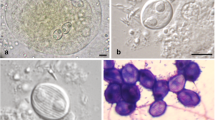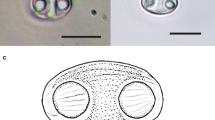Abstract
During a survey of myxozoan parasites of freshwater fish from the São Francisco River in Minas Gerais State, Brazil, plasmodia of Myxidium ceccarellii n. sp. were found in gallbladders of two out of six specimens (22 %) of Leporinus elongatus (Anastomidae). Parasite plasmodia were translucent and greenish, with disporic sporoblasts that develop asynchronously. Mature myxospores were ellipsoidal in frontal and lateral views, with slightly pointed ends. The surfaces of each valve had four to six longitudinal grooves. Spores dimensions were as follows: length 17.7 ± 0.5 μm (17.1–18.1), width 10.4 ± 0.47 μm (9.8–11.3), and thickness 10.1 ± 0.27 μm (9.6–10.4). Two polar capsules, one at either end of the spore, had the length of 6.3 ± 0.5 μm (5.7–7.0) and width of 6.4 ± 0.44 μm (5.7–6.9), with four to five polar filament turns. Some aberrant spores had one or three polar capsules. Partial sequencing of M. ceccarellii n. sp. small subunit ribosomal RNA (ssrRNA) gene resulted in 1,845 bp. This is the first molecular study of a Myxidium species that parasitizes a South American freshwater fish. Phylogenetic reconstruction using ssrRNA gene sequences showed that M. ceccarellii n. sp. was positioned basally in a recognized clade of myxozoans that infect the biliary systems of nonfish vertebrates.





Similar content being viewed by others
References
Altschul SF, Madden TL, Schäffer AA, Zhang J, Zhang Z, Miller W, Lipman DJ (1997) Gapped BLAST and PSI-BLAST: a new generation of protein database search programs. Nucleic Acids Res 25:3389–3402
ANA-Agência Nacional de Águas (2012) Região Hidrográfica Amazônica: A maior do mundo em disponibilidade de água http://www2.ana.gov.br/Paginas/portais/bacias/amazonica.aspx. Accessed on 19 Mar 2012
Azevedo C, Casal G, Clemente SC, Lopes LMS, Matos P, Abdel-Baki AA, Oliveira E, Matos E (2011) Myxidium volitans sp. nov., a parasite of the gallbladder of the fish, Dactylopterus volitans (Teleostei: Triglidae) from the Brazilian Atlantic coast—morphology and pathology. Mem Inst Oswaldo Cruz 106:557–561
Barta JR, Martin DS, Liberator PA, Dashkevicz M, Anderson JW, Feighner SD, Elbrecht A, Perkins-Barrow A, Jenkins MC, Danforth D, Ruff MD, Profous-Juchelka H (1997) Phylogenetic relationships among eight Eimeria species infecting domestic fowl inferred using complete small subunit ribosomal DNA sequences. J Parasitol 83:262–271
Bartholomew JL, Atkinson SD, Hallett SL, Lowenstine LJ, Garner MM, Gardiner CH, Rideout BA, Keel MK, Brown JD (2008) Myxozoan parasitism in waterfowl. Int J Parasitol 38:1199–1207
Eiras JC, Saraiva A, Cruz CF, Santos MJ, Fiala I (2011) Synopsis of the species of Myxidium Bütschli, 1882 (Myxozoa: Myxosporea: Bivalvulida). Syst Parasitol 80:81–116
Fiala I (2006) The phylogeny of Myxosporea (Myxozoa) based on small subunit ribosomal RNA gene analysis. Int J Parasitol 36(14):1521–1534
Froese R, Pauly D (2009) FishBase. WorldWideWeb electronic publication. Version (03/2009) www.fishbase.org (accessed 30 Jan 2012)
Garavello JC, Britski HA (2003) Parotocinclus planicauda, a new species of the subfamily Hypoptopomatinae from southeastern Brazil (Ostariophysi: Loricariidae). Braz J Biol 63:253–260
Guindon S, Dufayard JF, Lefort V, Anisimova M, Hordijk W, Gascuel O (2010) New algorithms and methods to estimate maximum-likelihood phylogenies: assessing the performance of PhyML 3.0. Syst Biol 59:307–321
Hall TA (1999) BioEdit: a user-friendly biological sequence alignment editor and analysis program for Windows 95/98/NT. Nucleic Acids Symp 41:95–98
Hallett SL, Diamant A (2001) Ultrastructure and small subunit ribosomal DNA sequence of Henneguya lesteri n. sp. (Myxosporea), a parasite of sand whiting Sillago analis (Sillaginidae) from the coast of Queensland, Australia. Dis Aquat Org 46:197–212
Hartigan A, Fiala I, Dyková I, Jirků M, Okimoto B, Rose K, Phalen DN, Šlapeta J (2011) A suspected parasite spill-back of two novel Myxidium spp. (Myxosporea) causing disease in Australian endemic frogs found in the invasive Cane Toad. PLoS ONE 6:e18871
Hartigan A, Fiala I, Dyková I, Rose K, Phalen DN, Slapeta J (2012) New species of Myxosporea from frogs and resurrection of the genus Cystodiscus Lutz, 1889 for species with myxospores in gallbladders of amphibians. Parasitology 139:478–496
Heiniger H, Adlard RD (2014) Relatedness of novel species of Myxidium Bütschli, 1882, Zschokkella Auerbach, 1910 and Ellipsomyxa Køie, 2003 (Myxosporea: Bivalvulida) from the gall bladders of marine fishes (Teleostei) from Australian waters. Syst Parasitol 87:47–72
Jirku M, Bolek MG, Whipps CM, Janovy J Jr, Kent ML, Modry D (2006) A new species of Myxidium (Myxosporea: Myxidiidae), from the western chorus frog, Pseudacris triseriata triseriata, and Blanchard’s cricket frog, Acris crepitans blanchardi (Hylidae), from eastern Nebraska: morphology, phylogeny, and critical comments on amphibian Myxidium taxonomy. J Parasitol 92:611–619
Karlsbakk E, Køie M (2012) The marine myxosporean Sigmomyxa sphaerica (Thélohan, 1895) gen. n., comb. n. (syn. Myxidium sphaericum) from garfish (Belone belone (L.)) uses the polychaete Nereis pelagica L. as invertebrate host. Parasitol Res 110:211–218
Kent ML, Khattra J, Hedrick RP, Devlin RH (2000) Tetracapsula renicola n. sp. (Myxozoa: Saccosporidae); the PKX myxozoan—the cause of proliferative kidney disease in salmonid fishes. J Parasitol 86:103–111
Levêque C, Oberdorff T, Paugy D, Stiassny MLJ, Tedesco PA (2008) Global diversity offish (Pisces) in freshwater. Hydrobiology 595:545–567
Lom J, Arthur JR (1989) A guideline for the preparation of species descriptions in Myxosporea. J Fish Dis 12:151–156
Posada D (2008) jModelTest: phylogenetic model averaging. Mol Biol Evol 25:1253–1256
Rambaut A (2009) Molecular evolution, phylogenetics and epidemiology. FigTree v1.3.1. Disponible in http://tree.bio.ed.ac.uk/software/figtree/. Accessed in 2 May 2012
Santos EB, Vieira EFS, Cestari AR, Barreto LS (2009) Caracterização de escamas do peixe piau (Leporinus elongatus) e sua aplicação na remoção de Cu(II) de meio aquoso. Quim Nova 32(1):134–138
Sato Y, Fenerich-Verani N, Godinho HP (2003) Reprodução induzida de peixes da bacia do São Francisco. In: Godinho HP, Godinho AL (eds) Águas, peixes e pescadores do São Francisco das Minas Gerais. PUC Minas, Belo Horizonte, pp 275–289
Vari RP, Malabarba LR (1998) Neotropical ichthyology: an overview. In: Malabarba LR, Reis RE, Vari RP, Lucena ZMS, Lucena CAS (eds) Phylogeny and classification of neotropical fishes. EDIPUCRS, Porto Alegre, pp 1–11
Welcomme RL (1985) River fisheries. FAO Fish. Tech Pap 262:1–330
Acknowledgments
Part of this study was supported by the Brazilian fostering agency CNPq (grant number 472747/2012-6). We thank the National Center for Research and Conservation of Continental Fish (CEPTA/ICMBio) for support during the field work and Ricardo Torres de Oliveira (CEPTA/ICMBio) for his help with fish dissections.
Author information
Authors and Affiliations
Corresponding author
Rights and permissions
About this article
Cite this article
Adriano, E.A., Silva, M.R.M., Atkinson, S.D. et al. Myxidium ceccarellii n. sp. (Myxosporea) from the gallbladder of Leporinus elongatus (Anastomidae) from the São Francisco River, Brazil. Parasitol Res 113, 2665–2670 (2014). https://doi.org/10.1007/s00436-014-3921-x
Received:
Accepted:
Published:
Issue Date:
DOI: https://doi.org/10.1007/s00436-014-3921-x




